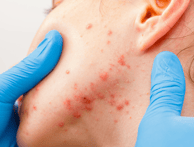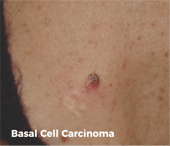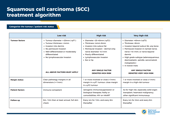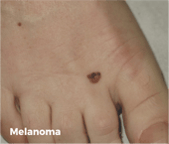Common skin bumps and how to tell if they are a cause for concern
Throughout our lifetimes, our skin plays host to all kinds of lumps and bumps – many of which are harmless, but there are some worth monitoring and even getting checked by a doctor. Here are some common causes of skin bumps as well as signs that indicate a more serious cause for concern.
Benign skin growths
The most common bumps on the skin are benign growths such as moles and cysts. Moles appear as small, brown bumps and cysts are sac-like pockets of tissue that contain fluid or air. While benign growths are harmless to your health, you can typically get them removed if they are bothersome.
 Inflammatory conditions
Inflammatory conditions
Inflammatory conditions like acne and rosacea can create pupules (bumps), cysts and pustules (tender, red bumps often filled with pus). Typically, these conditions cause some pain and discomfort and can usually be treated with topical creams, oral medications, and aesthetic treatments like LED light therapy and microdermabrasion.
Keratosis pilaris
A somewhat common condition in adults is keratosis pilaris, which causes small, rough bumps to appear on the skin – usually on the upper arms, face, thighs or back. These bumps are plugs of dead skin cells and are generally harmless. There are some topical treatments that can help smooth out the texture of the bumps and decrease redness.
Folliculitis
Folliculitis is inflammation around a hair follicle that is often partially due to an ingrown hair. It can appear as a small, red, inflamed bump resembling acne. Most cases resolve themselves over time but you should avoid irritating it further and keep it clean with anti-bacterial wash.
Skin tags
Skin tags are fleshy growths of skin commonly seen on the neck, armpits, breasts and thighs. They often appear as people get older but are benign and painless. No treatment is necessary, but they can be removed if they are bothersome.
Epidermoid cysts
Epidermal cysts are small, hard lumps that move under the skin and are filled with keratin material. These cysts don’t require treatment but they can be surgically removed if necessary.
Lipomas
A lipoma is a slow-growing benign tumour of fat tissue. Like cysts, they vary in size and move under the skin. While they don’t require treatment, they can be excised depending on size and location.
 Basal cell carcinoma
Basal cell carcinoma
Basal cell carcinoma is the most common type of skin cancer affecting Australians. It often looks like an open sore, red patch, scar, or a shiny pink or pearly white bump. It is predominantly caused by repeated and unprotected exposure to the sun’s UV radiation and is therefore most often seen in sun-exposed areas of the body like the head. This type of skin cancer can usually be treated with surgical excision, topical treatments or cryotherapy (freezing).
 Squamous cell carcinoma
Squamous cell carcinoma
Squamous cell carcinoma presents as a dome-shaped, red, scaly patch of skin. It can often evolve into a bump that ulcerates in the centre or bleeds easily. Like basal cell carcinoma, this form of skin cancer is mostly caused by sun exposure. It is most often treated with surgery and/or radiation therapy and, if left untreated, can cause significant scarring and disfigurement
Melanoma
Melanoma is a serious form of skin cancer that can sometimes be difficult to detect. Like most skin cancers, it is commonly caused by UV exposure. However, melanoma can also be hereditary and doesn’t always appear in sun-exposed areas. For example, the disease can develop on the soles of feet, under fingernails and even inside the mouth.

Melanomas also don’t always appear as a typical ‘dark mole’. Follow the ABCDE Melanoma Guide to know what to look for.
Melanoma can be deadly if not treated early. Treatments include radiation and chemotherapy, and surgery to remove the melanoma itself as well as any other places it may have spread to, including the lymph nodes. Melanoma can quickly spread to the brain, lungs and other organs, so early detection is essential.
Symptoms of a serious issue
It’s always worth getting your skin checked by a professional if you are concerned about any of the bumps on your body. A few red flags indicate an immediate cause for concern, including:
- Red or pink scaliness unrelated to dry skin
- Areas that bleed easily
- Tender or painful lumps
- Frequent itching
- A sore that won’t heal
- A bump that gets bigger over time
Even if you don’t have any concerning lumps and bumps, it’s a wise idea to get your skin checked by a medical professional at least once a year to avoid missing anything you haven’t noticed.
This is a general outline of symptoms and skin conditions. You should always speak with your healthcare provider to receive a diagnosis or medical advice.
- Tags:
- Detection
